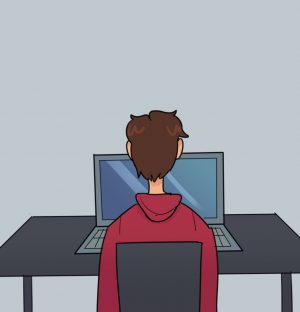For now, at-home learning is what’s best for Edina students
April 12, 2021
Seven months into the COVID-19 pandemic, the world isn’t getting any more used to it. People are desperate to get back into offices and restaurants, and they long for the socialization we all once took for granted. Reopening processes are beginning, albeit slowly, including Edina High School students being given the option of hybrid learning this semester. However, a month into the 2020-2021 school year, it still seems that Edina Virtual Academy, or EVA, is the more enriching choice.
Hybrid students come into school two days a week. The first half of the alphabet takes Monday and Tuesday, followed by the second half on Thursday and Friday. Their masks stay on the entire time as they sit in quiet, nearly empty classrooms, appropriately socially distanced from their fellow scholars. These are, of course, measures EHS is taking to keep its students and staff safe, the importance of which should not be undermined. Nevertheless, it makes for an uncomfortable, almost dystopian atmosphere that is sure to wear on the psyche of Edina’s teens. With half their friends gone, designated walkways, and an invisible six-foot forcefield around each kid, the social aspect of going to school is just about eliminated.
School is looking like something out of a “Hunger Games” novel. Teens are craving familiarity, and nothing is more familiar than one’s own home. EVA students reap the benefits of being able to learn right from their bedrooms and are able to do their assignments at their own pace, step outside for a quick breath of fresh air, and even get a few extra minutes of sleep each morning. All of these add up to a more eased mindset in this world of discomfort. And don’t think that online learning is making students into hermits; EVA students have the opportunity to collaborate with one another through FaceTime and other digital avenues, making for arguably more communication than hybrid students are getting.
The most obvious advantage to hybrid learning is the chance for students to make meaningful connections with their teachers. Communicating through a screen is never the same as a face-to-face conversation. But with COVID keeping us apart, and even the way we use technology today, is that connection even there? Kids coming into school are still spending some entire class periods on Google Meets, despite the fact that their teachers are right there in the room. Teachers are having to juggle keeping both their online and in-person students engaged in their learning, which is not an easy feat. They’re having to create two separate curriculums that fit the needs and accessabilities of every kid under their supervision. This is a lot to ask from a group of people already working ridiculously hard everyday to shape today’s youth into successful, hard working adults.
The last few months have brought altered routines, changes in the way we must behave, missed life events, and all kinds of other hardships. Teens are not as well-suited to constant adaptation as adults are. A survey conducted by the Center for Disease Control in June stated that 40.9% of interviewees noticed “at least one adverse mental or behavioral health condition” brought about by today’s coronavirus climate. A whopping 10.7% of respondents had considered suicide in the last 30 days. This was coming from presumably well-adjusted adults. If that’s where they were at, there’s no telling what the average hormonal, emotional teenager could be feeling. Furthermore, according to medical journal JAMA, a second wave of mental health struggle is on the way. The best way for us to prepare our teens is to give them a sense of routine, comfort, and familiarity, one that cannot be instilled by the plexiglass barriers and mask-clad faces of hybrid learning. Online school gives students a chance to look around them and see something they recognize, something that feels like home.
Come second semester, EHS will hopefully have more opportunities to get more kids in school learning, together. But for now, it’s just not plausible. We all did online learning last spring and did well with it, so we know it’s an option. It’s just a matter of determining which option is best suited for each student individually.







